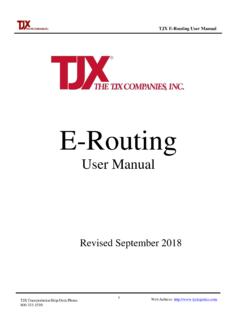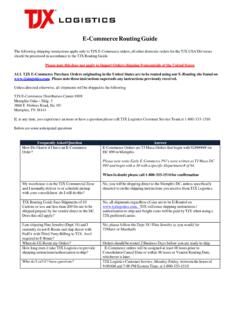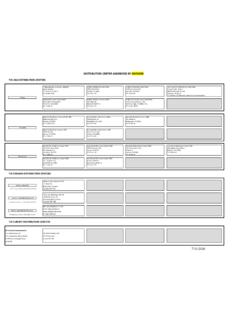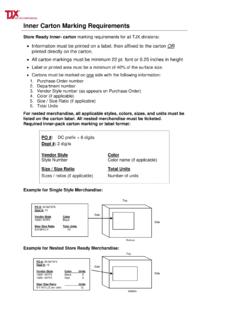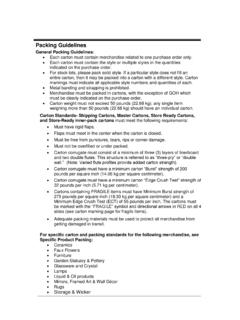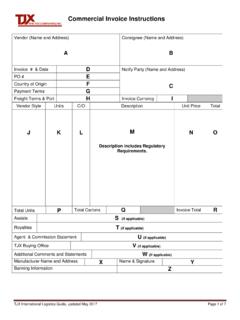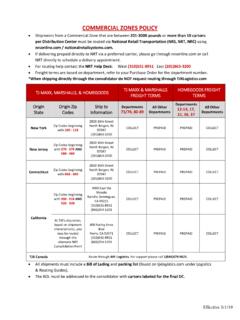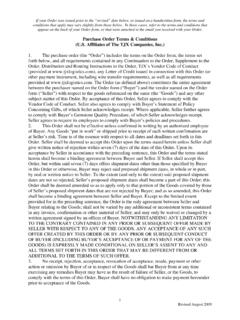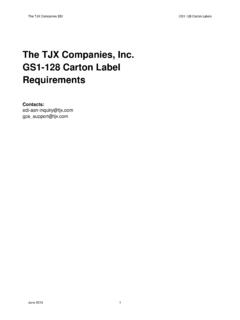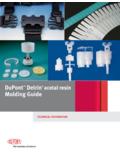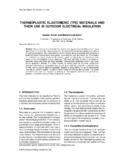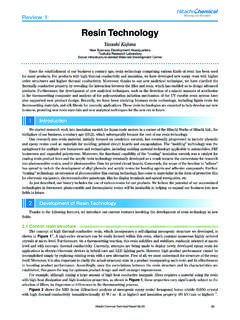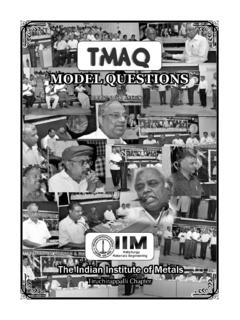Transcription of TJX Sustainable Packaging Recommendations
1 Updated July 2018 1 TJX Sustainable Packaging Recommendations The TJX Companies has long been committed to pursuing initiatives that are smart for our business and good for the environment. The TJX Companies supports the implementation of the 3R s of reduce, reuse and recycle. Packaging materials received from our vendors represent a substantial amount of the TJX waste footprint. We strive to re-use and recycle these materials at our distribution centers and stores; however we recognize the value in working with vendors to ensure that we are receiving the most efficient and Sustainable Packaging appropriate for the enclosed product.
2 By reducing Packaging we divert more waste from landfill, improve container cube to reduce emissions, increase productivity and reduce costs. To this end, we have developed the following considerations and preferences for vendors who are packing merchandise for non-breakable or non-fragile merchandise for shipment to TJX. The safety of your products is the most important criteria, and at no time should changes to Packaging incur or promote additional damages, breakages, mold, infestation or other conditions that make merchandise non-salable upon receipt by TJX. The merchandise needs to travel safely from your factories through our supply chain to our stores.
3 TJX requires vendors to fully adhere to its Packaging guidelines document available on our website. When store ready pack sizes have been agreed upon with your buyer, we ask that you attempt to use the environmental suggestions provided where possible. TJX Packaging guidelines: For more information regarding the TJX Packaging guidelines referenced throughout this document, visit the Carton Marking section of the website. If there are any questions please e mail us at Thank you for partnering with us to help reduce our impact on the environment. Updated July 2018 2 Common Examples of Excessive Packaging : 1. Unnecessary Strapping: Does the box have unnecessary strapping?
4 Solution: Secure boxes tightly with tape to avoid using rigid strapping materials which cannot be recycled and diverted from landfill. 2. Box within a Box: Is there a second box (a non-consumer Packaging box) within the shipping carton that is the same size, or close in size to the shipping carton itself ( box within a box)? Solution: Use one appropriately sized box, that meets the durability requirements outlined in our Packaging guidelines, to hold the weight of its contents on its own. 3. Boxes/Bags within Boxes/Bags: In situations where moisture levels do not need to be controlled by desiccants or specific merchandise characteristics do not require additional protection, are multiple items being individually bagged or boxed and then bagged or boxed again?
5 Solution: o Only use plastic where the characteristics of the product require it for safe transit. o If plastic is needed to protect merchandise from moisture, you can choose to line the box with one large plastic bag to ensure all items are protected without having to be individually bagged or boxed. o When packing fabric merchandise that is not easily wrinkled, snagged, torn or otherwise damaged, pack multiple items in a single plastic bag. o We do not require the inclusion of plastic bags for glass, ceramic or wood merchandise. o When plastic bags are used, we recommend that the resin identification code is printed on all plastic bags as well as suffocation warning.
6 4. Appropriate Carton Size: Is the size of the carton too large for the merchandise that it contains? Is there excess space requiring space fillers, Solution: Use the appropriately sized box to ensure to limit the amount of excess space. If space fillers are required, use recyclable materials such as shredded newspaper or corrugate as opposed to polystyrene (Styrofoam)/peanuts. Updated July 2018 3 5. Too Much Protective Packaging : Is the merchandise individually wrapped in too much protective Packaging such as tissue paper, bubble wrap or Styrofoam? Is the shipping carton unnecessarily separated by cardboard or Styrofoam dividers or trays?
7 Solution: Avoid unnecessary fillers by packing merchandise tightly in an appropriately sized box to ensure less shifting. This will reduce the amount of protective Packaging and/or dividers required to ensure safe transport. Other Environmentally Friendly Packaging Tips: Reduce - As a vendor, always ask yourselves the following key questions to determine if your Packaging is excessive: i. Is the merchandise unnecessarily grouped using additional boxes or plastic bags? ii. Is the shipping carton appropriately sized for the merchandise it contains? iii. Is the Packaging required to prevent the damage or breakage of the merchandise?
8 Reuse quality Packaging materials where possible: i. Clean shipping cartons left over from your own supply deliveries that meet our Packaging guidelines. ii. Clean bubble wrap or packing paper iii. Shredded office paper or folded cardboard scraps as space fillers iv. All corrugate cartons must be assembled without the use of staples Recycle - TJX distribution centers recycle cardboard, and in some cases plastic wrap as well. We prefer to receive Packaging made from materials that are easily accepted into the general recycling stream instead of bubble wrap or polystyrene (Styrofoam). If bubble wrap is used, we prefer to receive bio-degradable bubble wrap.
9 I. Is there an alternative to Styrofoam that is available to me? We would rather avoid polystyrene (Styrofoam) altogether where feasible and prefer to receive clean paper or paper pulp derivative products instead. ii. Are there packing materials available that contain post-consumer recycled content? Please use them whenever possible. iii. Is the packing material able to be easily recycled in traditional recycling programs? The safety of your products is the most important criteria. The merchandise needs to travel safely from your factories through our supply chain to our stores. When store ready pack sizes have been agreed upon with your buyer, we ask that you attempt to use the environmental suggestions provided where possible.
10 If there are any questions please e mail us at Updated July 2018 4 Packing Guidelines General Packing Guidelines: Each carton must contain merchandise related to one purchase order only. Each carton must contain the style or multiple styles in the quantities indicated on the purchase order. For stock lots, please pack solid style. If a particular style does not fill an entire carton, then it may be packed into a carton with a different style. Carton markings must indicate all applicable style numbers and quantities of each. Metal banding and strapping is prohibited, unless it is an exempt category. Merchandise must be packed in cartons, with the exception of GOH which must be clearly indicated on the purchase order.
